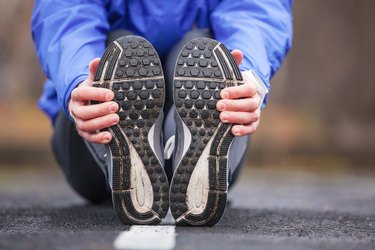
You don't have to experience soreness, tightness or discomfort in your hamstrings after exercise. While a little soreness after exercise is normal, repeated or prolonged soreness in your hamstrings after exercise can be an indication that the intensity of your workout is too high.
By employing a few preventive measures and some rehabilitation, you can heal your sore hamstrings and prevent future soreness.
Video of the Day
Video of the Day
What Causes Sore Hamstrings?
Having mildly sore hamstrings after a workout is normal. As you exercise, your muscle fibers tear and heal naturally.
Prolonged periods of soreness that occur one to two days after exercising isn't normal, though. Delayed-onset muscle soreness (DOMS) is common if you've recently changed your routine or increased the intensity of your workout, and it's an indication that you need to dial back your routine.
Soreness or stiffness in the three major muscle groups that make up the hamstrings is also especially common in individuals who sit for long periods. These muscle groups remain compressed if you remain in your chair for most of the day. Compressed hamstrings naturally lose their flexibility over time, which can cause soreness after a workout.
Rest and Avoid Overtraining
The best way to avoid sore hamstrings is to avoid overtraining. If you're attempting a new activity, make sure you're building up the intensity of your new routine slowly, giving your muscles time to heal and rebuild between sessions.
Working a rest day in at least once a week can give your sore hamstrings a chance to recover so that you don't risk an injury. If you do experience symptoms associated with DOMS, discontinue exercise and let your body heal. Seek a sports therapist or doctor's advice if the soreness persists.
Incorporate a Stretching Routine
Stretching can help prevent sore hamstrings by increasing your flexibility. A daily stretching regimen improves your hamstrings range of motion over a few weeks or months.
To perform a supine hamstrings stretch, lie on your back with your left knee bent and your left foot flat on the floor, and stretch your right leg straight up. You can rest your right leg along the corner of a wall or door jamb for stability. Slowly straighten your right knee so that your leg flattens against the wall, stretching your hamstring.
Feel as though you're pulling your heel upward toward the ceiling while exhaling slowly. Hold this position for about 30 seconds and do a few repetitions before switching legs.
Other Hamstring-Healing Tips
Prevent a hamstring strain or sore hamstrings by introducing a few other basic lifestyle changes. As a starting point, make sure you're hydrating well throughout your workout routine and follow each session with a healthy amount of high-quality protein so that your muscle fibers can rebuild and heal between workouts.
Encourage healing through massage therapy, which increases blood flow to your sore hamstring muscles, helping them to heal faster and regain flexibility.
Is this an emergency? If you are experiencing serious medical symptoms, please see the National Library of Medicine’s list of signs you need emergency medical attention or call 911.